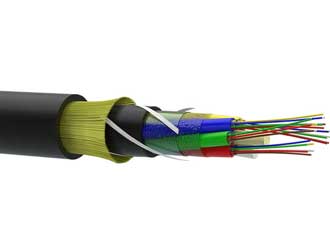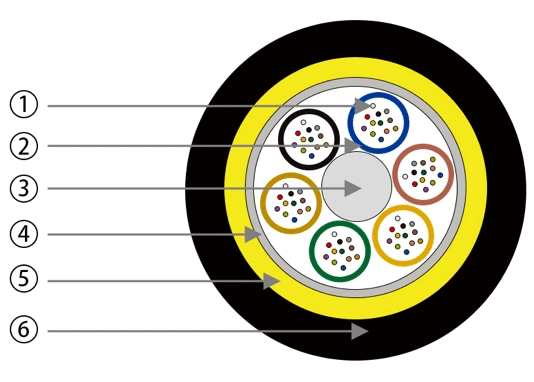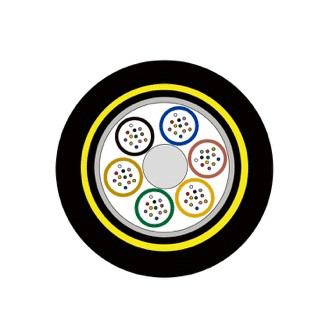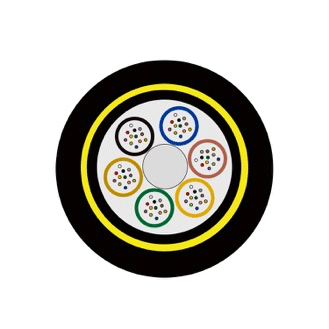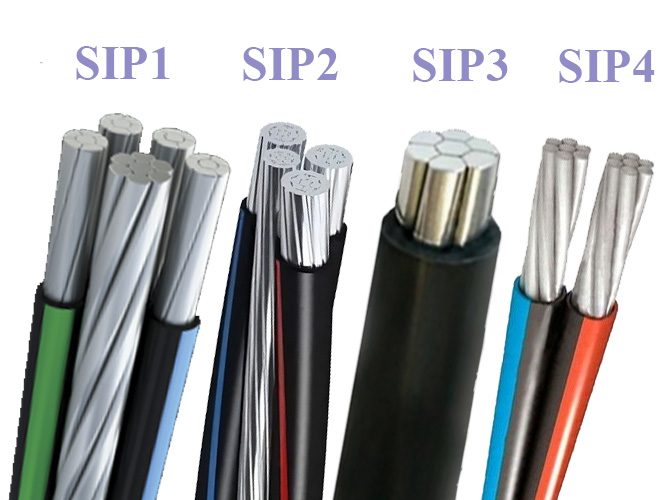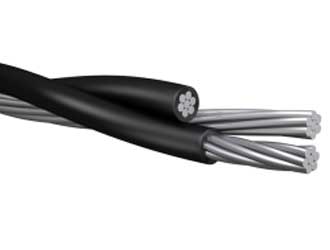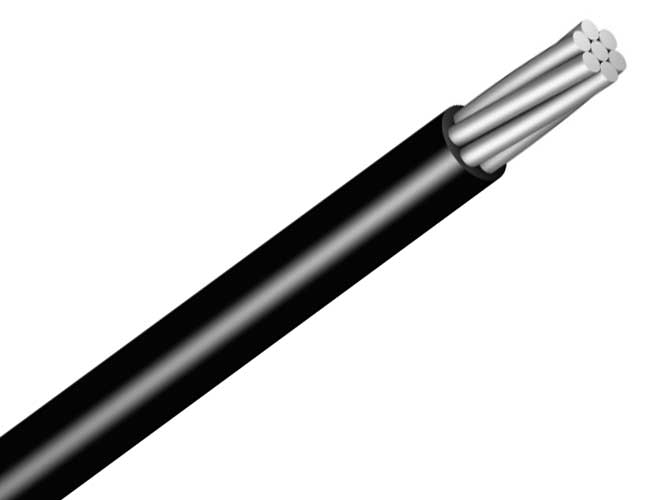Applications of ADSS Cables:
Telecommunications: Used by telecom operators to connect long-distance networks and provide broadband services.
Power Utilities: Installed along power lines to provide communication channels for utility companies.
Broadband Networks: Deployed in rural and urban areas to deliver high-speed internet services.
The more and more ADSS fiber optic cable are applied in not just power line communication system, and also used for communication lines in areas where thunder and lightning is prone, large-span, and other overhead laying environments.
Key Features of ADSS Fiber Optic Cables:
All-Dielectric Construction: The cable is made entirely of dielectric materials, meaning it has no metallic components. This makes it immune to electromagnetic interference and suitable for installation in high-voltage areas.
Self-Supporting: ADSS cables are designed to support their own weight without the need for external support structures like messenger wires. This feature simplifies installation and reduces costs. ADSS fiber optic's an alternative to OPGW with lower installation costs.
High Tensile Strength: These cables are built to withstand significant mechanical stress, such as wind and ice loading, making them ideal for aerial applications.
Weather Resistance: ADSS cables are designed to endure harsh environmental conditions, including UV radiation, temperature extremes, and moisture.
Single Mode vs. Multimode Fiber Optic Cables:
Single Mode Fiber (SMF):
Transmission Distance: Suitable for long-distance communication, often up to hundreds of kilometers without the need for signal boosting.
Wavelengths: Operates primarily at wavelengths of 1310 nm and 1550 nm.
Applications: Long-haul telecommunications, metropolitan networks, and high-speed data centers.
Multimode Fiber (MMF):
Transmission Distance: More suitable for shorter distances, usually up to 2 kilometers, depending on the type and quality of the fiber and the transmission equipment used.
Wavelengths: Operates at wavelengths of 850 nm and 1300 nm.
Applications: Local area networks (LANs), data centers, and campus networks.
ADSS Optical Cable Parameters
ADSS single jacket
2.ADSS double jacket
Telecommunications: Used by telecom operators to connect long-distance networks and provide broadband services.
Power Utilities: Installed along power lines to provide communication channels for utility companies.
Broadband Networks: Deployed in rural and urban areas to deliver high-speed internet services.
The more and more ADSS fiber optic cable are applied in not just power line communication system, and also used for communication lines in areas where thunder and lightning is prone, large-span, and other overhead laying environments.
Key Features of ADSS Fiber Optic Cables:
All-Dielectric Construction: The cable is made entirely of dielectric materials, meaning it has no metallic components. This makes it immune to electromagnetic interference and suitable for installation in high-voltage areas.
Self-Supporting: ADSS cables are designed to support their own weight without the need for external support structures like messenger wires. This feature simplifies installation and reduces costs. ADSS fiber optic's an alternative to OPGW with lower installation costs.
High Tensile Strength: These cables are built to withstand significant mechanical stress, such as wind and ice loading, making them ideal for aerial applications.
Weather Resistance: ADSS cables are designed to endure harsh environmental conditions, including UV radiation, temperature extremes, and moisture.
Single Mode vs. Multimode Fiber Optic Cables:
Single Mode Fiber (SMF):
Transmission Distance: Suitable for long-distance communication, often up to hundreds of kilometers without the need for signal boosting.
Wavelengths: Operates primarily at wavelengths of 1310 nm and 1550 nm.
Applications: Long-haul telecommunications, metropolitan networks, and high-speed data centers.
Multimode Fiber (MMF):
Transmission Distance: More suitable for shorter distances, usually up to 2 kilometers, depending on the type and quality of the fiber and the transmission equipment used.
Wavelengths: Operates at wavelengths of 850 nm and 1300 nm.
Applications: Local area networks (LANs), data centers, and campus networks.
ADSS Optical Cable Parameters
ADSS single jacket
| fiber count | structure | fiber per tube | losse tube diameter(MM) | FRP/pad diameter (mm) | Thickness of outer jacket(mm) | Ref.Outer Diameter (mm) |
Ref.Weight (kg/km) |
|
| PE Jacket | AT Jacket | |||||||
| 4 | 1+6 | 4 | 1.9 | 2.0/2.0 | 1.7±0.1 | 9.8±0.2 | 83 | 93 |
| 6 | 1+6 | 6 | 1.9 | 2.0/2.0 | 1.7±0.1 | 9.8±0.2 | 83 | 93 |
| 8 | 1+6 | 4 | 1.9 | 2.0/2.0 | 1.7±0.1 | 9.8±0.2 | 83 | 93 |
| 12 | 1+6 | 6 | 1.9 | 2.0/2.0 | 1.7±0.1 | 9.8±0.2 | 83 | 93 |
| 24 | 1+6 | 6 | 2.0 | 2.0/2.0 | 1.7±0.1 | 9.8±0.2 | 86 | 96 |
| 48 | 1+6 | 12 | 2.0 | 2.0/2.0 | 1.7±0.1 | 10.0±0.2 | 89 | 99 |
| 72 | 1+6 | 12 | 2.2 | 2.0/2.0 | 1.7±0.1 | 10.5±0.2 | 99 | 109 |
| 96 | 1+8 | 12 | 2.2 | 2.0/3.4 | 1.7±0.1 | 12.0±0.2 | 124 | 136 |
| 144 | 1+12 | 12 | 2.2 | 3.0/7.2 | 1.7±0.1 | 15.2±0.2 | 176 | 189 |
| fiber count | structure | fiber per tube | losse tube diameter(MM) | FRP/pad diameter (mm) | Thickness of outer jacket(mm) | Ref.Outer Diameter (mm) |
Ref.Weight (kg/km) |
|
| PE Jacket | AT Jacket | |||||||
| 4 | 1+6 | 4 | 1.9 | 2.0/2.0 | 1.7±0.1 | 12.0±0.2 | 125 | 135 |
| 6 | 1+6 | 6 | 1.9 | 2.0/2.0 | 1.7±0.1 | 12.0±0.2 | 125 | 135 |
| 8 | 1+6 | 4 | 1.9 | 2.0/2.0 | 1.7±0.1 | 12.0±0.2 | 125 | 135 |
| 12 | 1+6 | 6 | 1.9 | 2.0/2.0 | 1.7±0.1 | 12.0±0.2 | 125 | 135 |
| 24 | 1+6 | 6 | 2.0 | 2.0/2.0 | 1.7±0.1 | 12.0±0.2 | 128 | 138 |
| 48 | 1+6 | 12 | 2.0 | 2.0/2.0 | 1.7±0.1 | 12.5±0.2 | 130 | 140 |
| 72 | 1+6 | 12 | 2.2 | 2.0/2.0 | 1.7±0.1 | 13.2±0.2 | 145 | 155 |
| 96 | 1+8 | 12 | 2.2 | 2.0/3.4 | 1.7±0.1 | 14.5±0.2 | 185 | 195 |
| 144 | 1+12 | 12 | 2.2 | 3.0/7.2 | 1.7±0.1 | 16.5±0.2 | 212 | 228 |
| Fiber core | Outer sheath | Span | Number of fiber cores per tube | Cable diameter(mm) | Cable unit weight(kg/km) | Rated tensile Strength (kN) | Maximum allowable tension (MAT,kN) |
| 12、24、36 | PE | 100 | 6 | 12.30 | 122 | 11.00 | 4.40 |
| 12、24、36 | PE | 200 | 6 | 12.50 | 126 | 16.00 | 6.40 |
| 12、24、36 | PE | 300 | 6 | 12.90 | 134 | 24.00 | 9.60 |
| 12、24、36 | PE | 400 | 6 | 13.20 | 140 | 30.63 | 12.25 |
| 12、24、36 | PE | 500 | 6 | 13.50 | 148 | 39.00 | 15.60 |
| 12、24、36 | PE | 600 | 6 | 13.80 | 156 | 48.00 | 19.20 |
| 12、24、36 | PE | 700 | 6 | 14.70 | 175 | 55.00 | 22.00 |
| 12、24、36 | PE | 800 | 6 | 15.00 | 182 | 62.00 | 24.80 |
| 48、72 | PE | 100 | 12 | 13.70 | 153 | 12.50 | 5.00 |
| 48、72 | PE | 200 | 12 | 14.00 | 159 | 19.25 | 7.70 |
| 48、72 | PE | 300 | 12 | 14.40 | 170 | 31.00 | 12.40 |
| 48、72 | PE | 400 | 12 | 14.50 | 173 | 34.50 | 13.80 |
| 48、72 | PE | 500 | 12 | 14.70 | 178 | 40.38 | 16.15 |
| 48、72 | PE | 600 | 12 | 15.10 | 186 | 49.63 | 19.85 |
| 48、72 | PE | 700 | 12 | 15.80 | 207 | 57.88 | 23.15 |
| 48、72 | PE | 800 | 12 | 16.10 | 213 | 64.75 | 25.90 |
| 12、24、36 | AT(220KV) | 100 | 6 | 12.30 | 133 | 11.00 | 4.40 |
| 12、24、36 | AT(220KV) | 200 | 6 | 12.50 | 138 | 16.00 | 6.40 |
| 12、24、36 | AT(220KV) | 300 | 6 | 12.90 | 146 | 24.00 | 9.60 |
| 12、24、36 | AT(220KV) | 400 | 6 | 13.20 | 152 | 30.63 | 12.25 |
| 12、24、36 | AT(220KV) | 500 | 6 | 13.50 | 160 | 39.00 | 15.60 |
| 12、24、36 | AT(220KV) | 600 | 6 | 13.80 | 168 | 48.00 | 19.20 |
| 12、24、36 | AT(220KV) | 700 | 6 | 14.70 | 189 | 55.00 | 22.00 |
| 12、24、36 | AT(220KV) | 800 | 6 | 15.00 | 196 | 62.00 | 24.80 |
| 48、72 | AT(220KV) | 100 | 12 | 13.70 | 166 | 12.50 | 5.00 |
| 48、72 | AT(220KV) | 200 | 12 | 14.00 | 172 | 19.25 | 7.70 |
| 48、72 | AT(220KV) | 300 | 12 | 14.40 | 183 | 31.00 | 12.40 |
| 48、72 | AT(220KV) | 400 | 12 | 14.50 | 186 | 34.50 | 13.80 |
| 48、72 | AT(220KV) | 500 | 12 | 14.70 | 192 | 40.38 | 16.15 |
| 48、72 | AT(220KV) | 600 | 12 | 15.10 | 201 | 49.63 | 19.85 |
| 48、72 | AT(220KV) | 700 | 12 | 15.80 | 222 | 57.88 | 23.15 |
| 48、72 | AT(220KV) | 800 | 12 | 16.10 | 228 | 64.75 | 25.90 |

